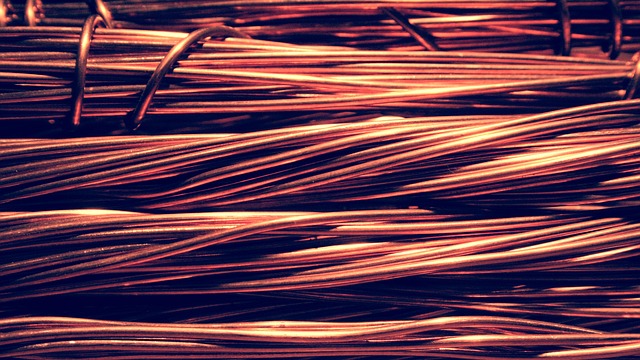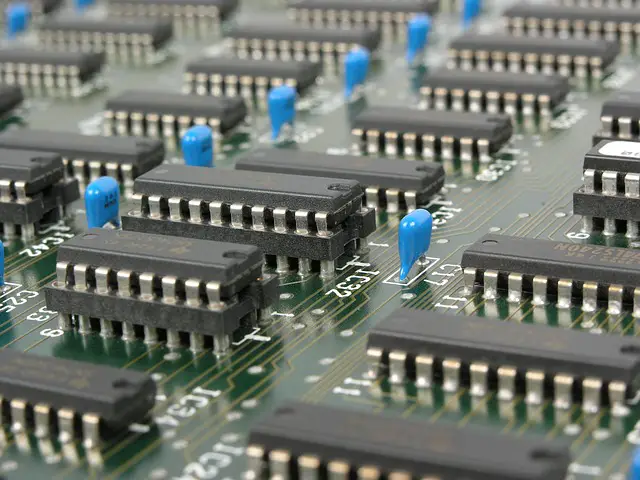Electrical Properties of Materials
Electrical properties determine if, and how, electricity will flow through a material. Some materials readily allow electrons to flow through them. These are called conductors because they ‘conduct’ electricity. Other materials prevent the flow of electrons. They are called insulators because they insulate against the flow of electric current. Some of the most important materials to electronics are semiconductors, which allow electrons to flow but not as well as conductors.

Within a computer’s CPU are millions of conductors, insulators, and semiconductors all working together.

Power transmission lines are made of conductors that allow electric current to flow over long distances.
Material properties help us to understand why some materials are conductors, some are semiconductors, and others are insulators.
Designers use these properties to protect us from harm and to make interesting devices. This includes the integrated circuit chips in your phone and computer, which use conductive pathways printed or deposited directly onto an insulative surface.
Electron flow also contributes to thermal conduction by moving energy in the form of heat. That’s why metals feel cold at room temperature but insulators can feel warm to the touch even below zero.
There are several types of electrical properties of materials. The most important is conductivity (the inverse of resistivity), which is defined as a material’s ability to conduct electric current. Resistivity is simply the inverse of conductivity, and is defined as a material’s ability to resist electric current.
Electrical Conductivity and Resistivity

Copper wire makes an excellent conductor.
Materials can be classified based on the ability of charged particles (usually electrons) to move through them. There are many things that contribute to this property, which is called conductivity. In general, good conductors have electrons that are free to move with just a little bit of a push. Resistors require a lot of energy to free their electrons. So much energy is required to make a resistor conduct electricity, that we often damage the material itself. So the ability of some materials to conduct electricity is really important in terms of being able to make useful circuits and electrical systems.
Conductivity is defined as a material’s ability to conduct electric current. It is the inverse of resistivity, which is defined as a material’s ability to resist current.
Conductivity and resistivity are the opposite of each other. Mathematically, they are each others’ inverse. Conductivity is represented by the Greek letter sigma (σ), and resistivity is represented by the Greek letter rho (ρ). When we say that they are each others inverse, we mean that each is defined by a fraction of 1 over the value of the other:
Conductivity: \sigma=\frac{1}{\rho} \\[2mm]
Resistivity: \rho=\frac{1}{\sigma}Materials are classified by types according to their conductivity/resistivity.
The three general classifications for materials are conductors, insulators, and semiconductors. A fourth category, which is mostly used in laboratories, is that of the superconductors. See our reference table on resistivity and conductivity for detailed figures on a wide variety of materials.
The following table shows general values for these types of materials.
| Material Type | Resistivity | Conductivity |
| Conductors | 10-8 | 107 |
| Insulators | 1016 | 10-15 to 10-25 |
| Semiconductors | 10-3 to 103 | 10-8 to 10-4 |
| Superconductors | 0 | ∞ |
As we would expect, the resistivity of conductors is very low, and the conductivity is very high. The opposite is true of insulators.
What Are Conductors?
Conductors are materials that allow relatively free movement of electrons. The most common examples of conductors are metals such as aluminum, copper, silver, and gold. Copper is the most common choice for wiring due to its’ high conductivity and low cost. Silver is an excellent conductor but tarnishes and is too expensive to use frequently. Other examples of good conductors are the human body and most tap water.
When electrons flow through a conductor, they don’t move at light speed. In fact, electrons often don’t travel very far at all. Instead, each electron pushes its’ neighbor just a bit. That electron pushes the next electron, and so forth. That’s how electricity works. In direct current systems (DC), the electrons keep pushing each other along through the machine. In alternating current (AC) systems, the electrons first push each other one way, and then back the way that they came. Electricity flows through AC and DC conductors differently, so different systems are used to make each as efficient as possible.
Metallic Bonding is Why Conductors Conduct
Metals are so good at conducting electricity because of how metal atoms chemically bond. This is called metallic bonding.
When atoms of metal bond together in a crystalline structure, they actually share electrons between them. These electrons are free to conduct if given just a little energy in the form of heat, light, or voltage. So when we apply even a small voltage (like a small battery) to a metal, its electrons begin to flow toward the positive terminal of the battery or voltage source.
| Material | ρ [Ω·m] at 20°C | σ [S/m] at 20°C |
|---|---|---|
| Silver, Ag | 1.59 × 10−8 | 6.30 × 107 |
| Copper, Cu | 1.68 × 10−8 | 5.96 × 107 |
| Gold, Au | 2.44 x 10-8 | 4.10 x 107 |
| Aluminum, Al | 2.82 × 10−8 | 3.50 × 107 |
Silver, copper, and gold each have only one electron in their outermost electron shell, called the valence shell. Remember that electrons stay bonded to an atom because the positive charge of protons attract the negative charge of the electron.
In silver, copper, and gold, there is only one electron at the farthest point from the positive charges (protons) in the atomic nucleus. It is relatively far from the positive charge of the nucleus, which is screened by the other, non-valence electrons that are between the nucleus and valence electrons. Therefore the valence electron in these metals tend to have a weaker bond to the nucleus than atoms with other electron configurations.
Each atom in a block of silver, copper, or gold, contributes one electron that is available for electrical conduction. These electrons are relatively free to drift in a phenomenon called the ‘electron sea‘.
While some metals are excellent conductors, all metals in the real world have internal structures that prevent perfect conduction. Defects are imperfections and can be found in every piece of metal in the real world. Defects cause electrons to scatter as they travel through the material, preventing optimal conduction. Luckily, it’s easy to produce conductors like copper that have ‘good enough’ conduction, even if imperfect. We cover this issue in much more detail in our lesson on electrical resistance.
Balancing Conductivity vs. Cost
Given unlimited funding, engineers would always choose to select materials with the most ideal properties. In the real world, cost is often a significant factor that must be taken into account.
For example, silver is the most conductive metal, as can be seen in the chart above. Copper is the next most-conductive, and aluminum is much less conductive than copper (nearly half as conductive as silver).
Yet due to the cost of silver, it is rarely used in electric circuits. Copper is commonly used in wiring but is prohibitively expensive in large quantities. For this reason, electric transmission lines are generally made out of aluminum, which is much cheaper than copper.
Sometimes other material properties make a different choice desirable. For instance, gold is sometimes used to plate electrical contacts despite the fact that it is more expensive, and less conductive, than copper. The reason is that gold does not oxidize like copper. Over time, copper develops an oxide patina that is visually appealing but electrically insulative. In contrast, the surface of a gold contact will remain pristine with no oxidation whatsoever. Gold can be plated with a very low thickness, making it both economical and productive to use in certain applications.
Properties of Insulators
Insulators are materials that do not allow free movement of electrons. Common examples are rubber, glass, plastics, and distilled water. Air is also a good insulator, which is why an exposed electric circuit does not usually arc through the air. However, any insulator can conduct electricity if the voltage is high enough- this is why lightning can travel through the air even though it is normally an insulator. In high voltage applications, vacuum is preferred over air in order to prevent arcing across the gap.

Wires are typically insulated to prevent current from flowing through other wires, people, or equipment.
Insulators don’t conduct because the electrons in an insulator are tightly bound to their atoms. While there is no such thing as a perfect insulator, the energy (called the bandgap energy) that it takes to free the electrons in an insulator is very large. At extremely high voltages, however, even a vacuum will conduct electricity. This is called electrical breakdown. Familiar examples are lightning and static electric shocks.
Going back to our ‘traffic model’ from Lesson 1, a conductor is like an open road with available ‘cars’ (electrons) for traffic to flow through. When we connect a conductor to an electric circuit, electrons can flow from the battery or power source through the metal. An insulator is like a road with brick walls between each car; the cars are there, but they can’t move. When we connect an insulator to an electric circuit, we have to force electrons into and through it in order to get traffic to flow- which takes a lot of energy. This would be like taking a bulldozer through the road with walls between the cars; you need to destroy the walls to allow traffic to flow. While you can do it, it’s not the easiest way.
Electrical Properties of Dielectric Materials
Many insulators are also called dielectric materials. Dielectrics are a type of insulator with a special additional property. They can store a lot of electrical energy in their atoms and molecules. This polarizability makes them great for capacitors.
When a voltage is applied across an insulator, it does not conduct electricity because its’ electrons are not free. Instead, its’ atoms and molecules become polarized. In other words, while the electrons don’t travel through the material in response to the voltage, the electrons and atoms inside the material do move a little. Sometimes the whole atom or even molecule moves a little. Thus there is a net separation of charge within the insulator, with a little more positive charge on one side and a little more negative charge on the other.
When you remove the voltage, the atoms, molecules, and electrons snap back into their starting positions. It turns out that this is a really helpful property when trying to make a capacitor, which is one of the most useful electric components.
There are two main electrical properties of dielectric materials:
- Dielectric materials have high resistivity.
- Dielectric materials are highly polarizable. This means that they can store a lot of energy in the electronic configuration of the material.
Properties of Semiconductors

Integrated circuits contain many (sometimes billions) of semiconductor devices.
Semiconductors are materials that have conductivity between conductors and insulators. Semiconductors require energy in order to conduct- some of this energy comes from the environmental temperature (heat). We usually have to apply electric potential energy (voltage) to force the semiconductor to act as a good conductor.
In real devices (like the billions of transistors inside your computer), a semiconductor substrate is impregnated with foreign atoms. This process is called doping. Doping allows us to engineer the electrical conductivity of different parts of the device. In other words, we can create entire circuits out of a single block of material. This led to the invention of integrated circuits, which are essential to the operation of modern day computers.
Superconductors
Superconductors are materials that are perfect conductors. They allow charge to move with zero resistance. Normally, a metal conductor’s resistivity decreases with temperature. As it gets colder, it becomes more conductive and less resistive. It would require a temperature of absolute zero (-273.15°C) for a perfect metal conductor to reach zero resistance. Since it is impossible to actually achieve absolute zero, there are no naturally occurring superconductors.
In contrast with conductors, a superconductor has a critical temperature (Tc) higher than absolute zero at which the resistance in the superconductor drops to zero. The critical temperature (Tc) is typically very low and superconductors often require cooling with liquid nitrogen in order to function.
Other Electrical Properties
There are other important electrical properties of materials as well. These include dielectric permittivity and strength, and the temperature coefficient of resistance.
Dielectric Permittivity
Permittivity describes the polarizability of a dielectric (resistive) material. A dielectric material stores energy by allowing its’ atoms and molecules to become polarized when a voltage is applied across it. This is how capacitors work. As we’ve learned, polarization occurs because even in insulators, the electrons, atoms, and molecules respond to an applied voltage by a small internal separation of charge.
Some insulators allow charge to be internally separated easily, which leads to a high dielectric permittivity.
In other words, how good is the material at being a capacitor?
This topic is covered in more detail in our lesson on dielectric materials.
Dielectric Strength
Dielectric strength is the measure of how much voltage it takes to achieve electrical breakdown of an insulator. Rubber, for instance, can withstand a higher voltage than air before breaking down. Diamond has one of the highest dielectric strengths of known materials, but the highest dielectric strength is that of a vacuum.
Check out our reference on dielectric strength for more information.
Temperature Coefficient of Resistance
Some materials experience an increase of resistance as the temperature is increased, and others experience a decrease. For example, metals conduct better at lower temperatures but semiconductors conduct better as the temperature is increased.
The temperature coefficient of resistance describes this property.
Conclusion
You don’t need to be an expert in all of these properties to learn electronics, but having an idea of what these properties are will help in understanding the fundamentals of circuits and electronics.
Of the properties, conductivity/resistivity is probably the most important material property to learn.
It is also important to remember that there is no such thing as a perfect conductor or insulator; even great conductors like copper have some resistance that must be taken into account, if for example, you require wiring of a significant length.
Next Up: We’ll continue to build on our knowledge of fundamental concepts related to electricity by exploring the concept of electric charge, in:
Lesson 6: Properties of Electric Charge